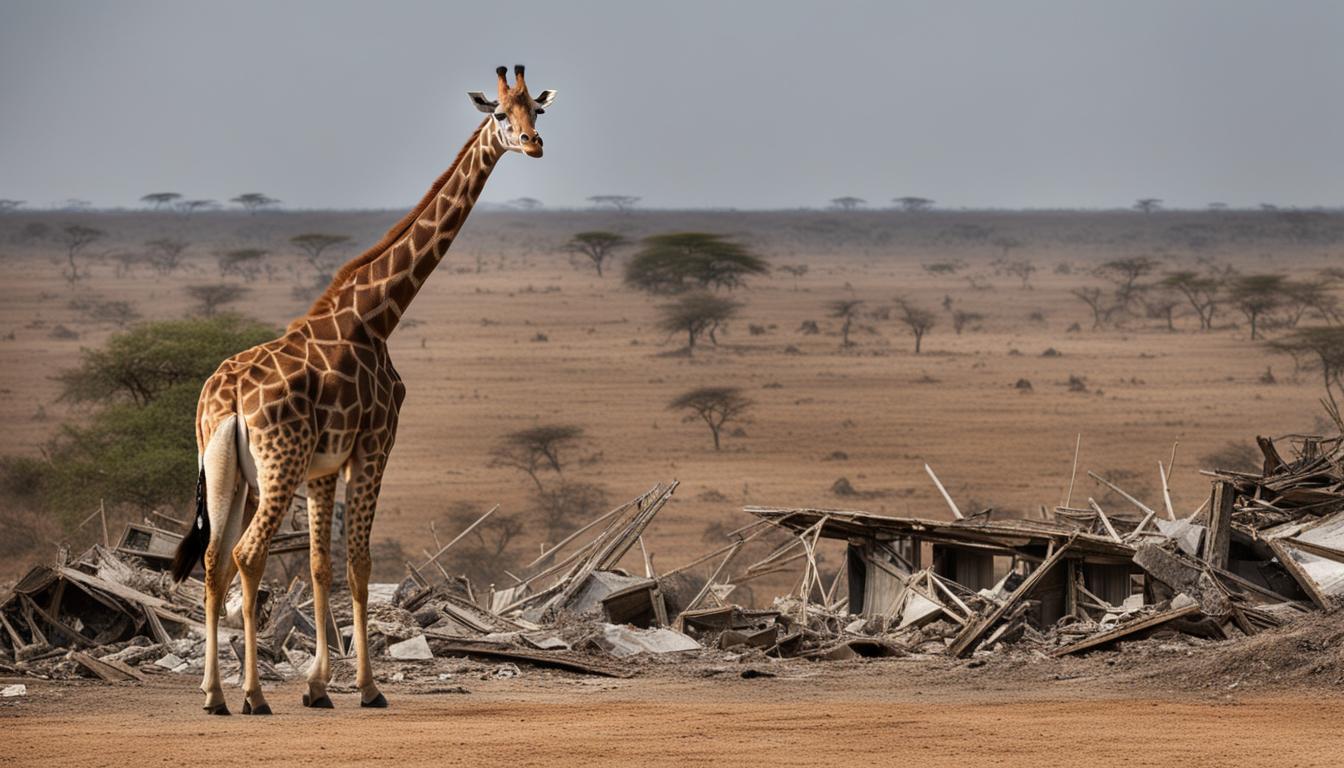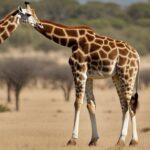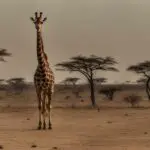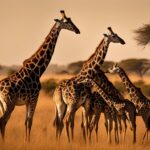Human-giraffe conflict poses a threat to giraffe populations in Africa. Factors such as habitat loss, habitat fragmentation, habitat degradation, human population growth, poaching, disease, war, and civil unrest contribute to this conflict. Habitat loss and degradation occur due to agricultural land demand, pastoralism, and unsustainable timber and fuel-wood harvesting. Giraffes also face competition for resources with humans and their livestock, leading to conflicts. Fragmentation of giraffe habitat isolates populations and limits genetic diversity exchange. Hybridization between giraffe species is also a concern. Lack of long-term studies and reliable data hinders conservation efforts, but progress is being made through genetic research. Conservation translocation projects, GPS satellite tracking, and understanding ecological factors such as predation and diseases are crucial for giraffe conservation.
The Silent Extinction of Giraffes
Giraffes, once thriving in the African savannah, are now facing a silent extinction. The giraffe population has significantly declined over the past three decades, mainly due to habitat loss, illegal hunting, and civil unrest. These factors have pushed giraffes to the brink of extinction, necessitating urgent conservation efforts.
Habitat loss and fragmentation pose a significant threat to giraffes. Rapid human population growth and urban development lead to the destruction and degradation of giraffe habitats. Industries such as agriculture and mining further encroach upon their territories. As their natural habitats shrink, giraffes struggle to find adequate food and water sources, impacting their survival.
Illegal hunting is another critical factor contributing to the decline of giraffe populations. Poachers target giraffes for their meat, pelts, bones, hair, and tails, driven by the demand for these products in various regions. Civil unrest and military actions exacerbate the situation, making it challenging to protect giraffes from indiscriminate hunting.
| Threat | Impact |
|---|---|
| Habitat loss | Reduces available food and water sources |
| Illegal hunting and trade | Diminishes giraffe populations |
| Civil unrest | Disrupts conservation efforts and increases poaching |
To address the silent extinction of giraffes, it is crucial to implement strict conservation measures. This includes protecting and restoring their habitats, imposing stricter regulations on hunting and trade, and promoting awareness and education about the importance of giraffe conservation. By addressing these challenges and working towards their resolution, we can ensure a future where giraffes continue to roam the African savannah.
Human-Wildlife Conflict and Drought
The ongoing drought in the Horn of Africa, particularly in Kenya, has exacerbated the human-wildlife conflict with giraffes. As water scarcity increases in giraffe habitats, these majestic animals are forced to search for water in human settlements, leading to conflicts. Giraffes, being perceived as competition for scarce water resources, can disrupt agriculture, further intensifying the conflict.
Along the Kenya-Somali border, the endangered reticulated giraffe faces human aggression due to restricted access to water sources. The scarcity of water not only affects the giraffe population but also contributes to food and water scarcity for both humans and wildlife. As climate change continues to impact weather patterns and increase the frequency of droughts, it is crucial to find sustainable solutions to mitigate the human-wildlife conflict.
Efforts to address this challenge involve implementing strategies that promote coexistence and shared resources between humans and giraffes. Creating alternative water sources, such as boreholes or water pans, can help meet the water needs of both communities. Additionally, community-based conservation initiatives that provide incentives for local communities to protect giraffes and their habitats can contribute to long-term conflict resolution.
Table: Human-Wildlife Conflict and Drought
| Challenges | Impact |
|---|---|
| Water scarcity in giraffe habitats | Forces giraffes to seek water in human settlements, leading to conflicts |
| Competition for water resources | Disrupts agriculture and intensifies the conflict |
| Human aggression towards giraffes in water-restricted areas | Endangers the reticulated giraffe population |
| Food and water scarcity | Affects both humans and wildlife |
| Climate change and increasing drought frequency | Exacerbates the problem and requires sustainable solutions |
By addressing water scarcity and fostering a collaborative approach to conservation, we can promote peaceful coexistence between humans and giraffes. Protecting the habitats and water sources that giraffes rely on is crucial for their long-term survival, as well as for ensuring a sustainable future for the communities that share their environment.
Image source: https://seo-writing.ai/32_6.png
Challenges in Giraffe Conservation
Giraffe conservation faces numerous challenges that threaten the long-term survival of these majestic creatures. One of the primary concerns is habitat loss, which is mainly driven by human activities such as urban development and agriculture. The growing human population and the need for resources have led to the destruction and fragmentation of giraffe habitats, limiting their range and access to food and water sources.
Another challenge is the low reproductive output of giraffes. They have a long gestation period and typically give birth to only one calf at a time, which hampers population recovery. With limited breeding opportunities, it becomes crucial to protect the existing individuals and ensure their habitats are secure.
| Challenges in Giraffe Conservation | Impact |
|---|---|
| Habitat Loss | Reduces the range and access to resources for giraffes |
| Low Reproductive Output | Hampers population recovery and genetic diversity |
| Unregulated Trade | Threatens giraffes through the illegal hunting and trade of their body parts |
Additionally, unregulated trade poses a significant threat to giraffe conservation. Giraffes are hunted for their body parts, including their meat, hides, and bones, which are sought after for their commercial value. The illegal trade in giraffe products, both domestically and internationally, further endangers their populations, particularly in countries with weak regulations.
“Protecting giraffes requires concerted efforts to address these conservation challenges. We need to focus on preserving their habitat, implementing stricter regulations to combat illegal trade, and promoting sustainable land management practices.”
Overall, addressing these challenges is essential for the long-term survival of giraffes. By prioritizing habitat protection, improving reproductive success rates, and regulating trade, we can make significant strides in conserving these iconic and unique animals.
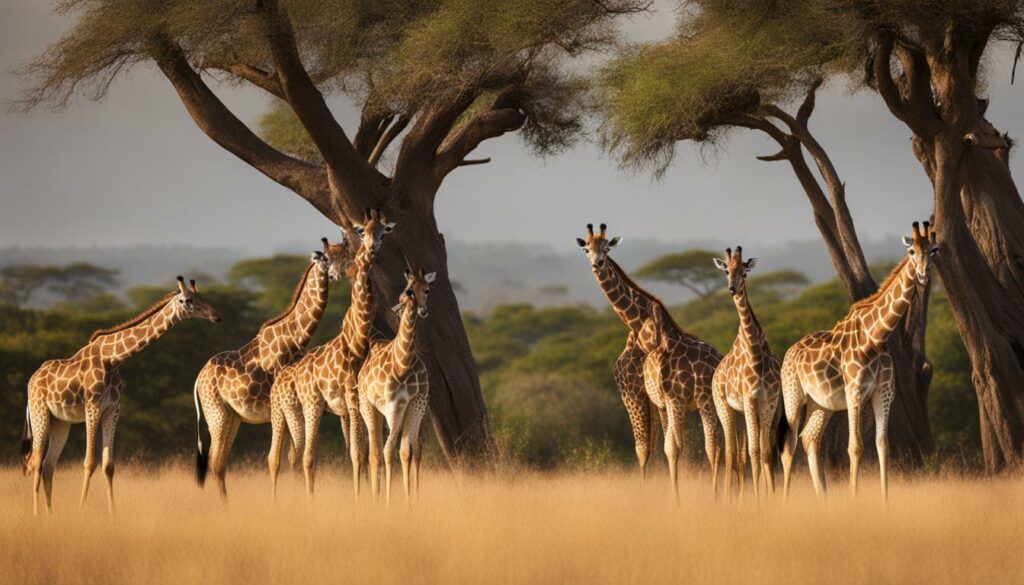
Conclusion
Human-giraffe conflicts have a significant impact on giraffe populations, but there are effective measures to mitigate these conflicts and protect these majestic animals. Conservation efforts must address the root causes of these conflicts, such as habitat loss and fragmentation. By protecting and restoring giraffe habitats, we can ensure the long-term survival of giraffes.
Regulating the trade of giraffe products is also crucial for their conservation. Policies should be implemented to prevent illegal hunting and the import of giraffe products, particularly in the United States. By reducing the demand for these products, we can deter poaching and help protect giraffes.
Research and data collection are vital for understanding giraffe populations and their interactions with humans. By conducting long-term studies and collecting reliable data, we can improve conservation strategies and make informed decisions. This includes tracking giraffes using GPS satellite technology and studying their ecological factors, such as predation and diseases.
Mitigating human-wildlife conflict is essential for giraffe conservation. Promoting sustainable land management practices and increasing habitat connectivity can reduce competition for resources between humans and giraffes. By working together and implementing these conservation measures, we can ensure that future generations can continue to be inspired by the beauty and grace of giraffes.
Does habitat loss contribute to human-giraffe conflicts?
Habitat loss and giraffe populations are interconnected in the context of human-giraffe conflicts. As human activities encroach upon natural giraffe habitats, these majestic creatures face heightened competition for resources, such as food and water, leading to increased conflicts with humans. Conservation efforts should address habitat loss to mitigate human-giraffe conflicts and ensure the long-term survival of giraffe populations.
FAQ
How do human-giraffe conflicts impact giraffe populations?
Human-giraffe conflicts pose a threat to giraffe populations in Africa. Factors such as habitat loss, habitat fragmentation, habitat degradation, human population growth, poaching, disease, war, and civil unrest contribute to this conflict.
What are the main factors contributing to the decline in giraffe populations?
The decline in giraffe populations is mainly due to habitat loss and fragmentation caused by growing human populations, urban development, agriculture, mines, and other industries. Illegal hunting and civil unrest also threaten giraffe populations.
How does drought exacerbate the human-wildlife conflict with giraffes?
Drought in the Horn of Africa region, particularly in Kenya, intensifies the human-wildlife conflict with giraffes. As giraffe habitat faces water scarcity, they are forced to seek water in human settlements, leading to conflicts.
What are the main challenges in giraffe conservation?
The challenges in giraffe conservation include habitat loss, low reproductive output, and unregulated trade. These factors hinder their population recovery and conservation efforts.
What can be done to mitigate human-giraffe conflicts and protect giraffes?
To mitigate human-giraffe conflicts and protect giraffes, measures such as addressing habitat loss, regulating trade, increasing research and data collection, and promoting sustainable land management practices are crucial. Increasing habitat connectivity and reducing human-wildlife conflict are also important for giraffe conservation.

